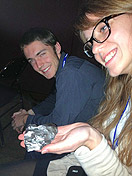News
A new direction for space industry
-
 Print
Print -
 Comments
Comments
-

UNC students Ekaterina Khvostova and Patrick Gray examine a meteorite that was passed around the audience during a talk by Chris Lewicki, president of Planetary Resources, the “asteroid-mining company.” Photo: HANNAH KERNER
SpaceVision 2012, the nation’s largest student-run space conference, drew a hodgepodge of space enthusiasts to downtown Buffalo last weekend. There were astronauts and engineers. There were NASA research center directors. There were executives from companies like Planetary Resources, which wants to mine asteroids, and Virgin Galactic, which plans to launch tourists into space.
It was, one might say, a gathering of dreamers.
UB’s Chapter of Students for the Exploration and Development of Space (SEDS) hosted the event, which took place from Nov. 8 to 11 in the Buffalo Niagara Convention Center. The objective: to enable students from across the country to hear from experts about the future of humanity in space.
About 300 people from across the country attended the conference, which served as SEDS’ annual U.S. convention.
Participants included students from such far-flung schools as Arizona State University, the University of Colorado at Boulder and the University of North Carolina at Chapel Hill. Organizers included UB SEDS past president Andrew Dianetti, who served as conference chair, and Mary Magilligan, UB SEDS president. Paul DesJardin, professor of mechanical and aerospace engineering, is the student group’s faculty advisory.
The overall message that emerged at SpaceVision 2012 was upbeat, with speakers from the public and private sectors agreeing that job opportunities are exciting and incredibly varied for students eyeing today’s space industry.
Though NASA retired its space shuttle program in 2011, the agency is developing a spacecraft with the capability of launching humans beyond low-Earth orbit—to the moon or maybe even Mars, NASA representatives said. Closer to home, a panoply of private firms are pouring money into space-based enterprises—like space tourism—that have never existed before.
“The future is actually really exciting now, and contrary to what the press says, we still are flying in space,” said Astronaut Peggy Whitson, the 13th chief of NASA’s astronaut office, who delivered a keynote address over lunch on Nov. 9.
Lesa Roe, director of NASA’s Langley Research Center, echoed those thoughts, telling students that the “end of the space shuttle program doesn’t mean the end of NASA sending humans into space. Quite the contrary, there’s lots going on.”
The enthusiasm at the conference provided a counterbalance to recent media reports, which have included an onslaught of sad, nostalgic news about the retirement of NASA’s space shuttle fleet. As SpaceVision presenters reminded their audiences, the end of one era marks the start of another.
Over and over again, SpaceVision presenters talked to students about the breadth of jobs available in the space industry, from astronauts and engineers to interior designers for spacecraft and communication professionals to educate the public about the importance of exploration.
“I got the impression, at least from the point of view of a lot of the space industry leaders and everyone who was at the conference, that there’s a great optimism about space,” said SpaceVision attendee Steven Coffed, a sophomore mechanical and aerospace engineering major. “But—and I think this might have been said—it’s not a blind optimism. Everybody recognizes that there’s a lot of work, a lot of long-term goals.”
Challenges for today’s space industry include overcoming technical hurdles in building spacecraft and rekindling the general public’s passion for space exploration, said Coffed, an aspiring space engineer and astronaut.
He spent most of the conference working behind the scenes, staffing the registration desk, meeting with reporters and helping to set up for panels. But he did find time to attend two presentations: talks by Rick Tumlinson and Chris Lewicki, two space entrepreneurs who have played instrumental roles in changing people’s perceptions of space exploration as a government-funded enterprise to an endeavor open to many different enterprises and people.
Lewicki was among the conference’s most sought-after speakers. He is president and chief engineer of Planetary Resources, the space mining firm. The company has made headlines around the world for its unusual goal of expanding Earth’s resource base by extracting raw materials from asteroids in our solar system.
Odd as that may sound at first, the firm has serious backing in the form of investors and advisors that include Google co-founder Larry Page and film director and explorer James Cameron.
At SpaceVision, Lewicki gave a rousing talk on why mining asteroids makes sense. He said it’s easier to travel to many asteroids than to the moon, and noted that some near-Earth asteroids are rich in platinum-group metals, which are relatively rare on Earth. His presentation included a slide with the title “Asteroids—A Limitless Opportunity.”
Like other conference presenters, Lewicki encouraged students to take a brave and enterprising view of the world. He recounted meeting Planetary Resources’ co-founders Eric Anderson and Peter Diamandis years ago.
“I met both of these gentlemen when I was your age, attending SEDS conferences and doing SEDS things, and we had worked together very often and said that one day we’ll do something (great) together,” Lewicki said. “And that day has come.”
The need to have a bold vision was a recurring theme at SpaceVision. With work and passion, dreams can become reality, the speakers said. Take it from an astronaut. Or an aspiring asteroid-miner.

Reader Comments